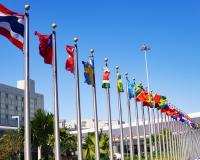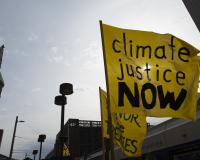
Vibrant Environment
All
All | Biodiversity | Climate Change and Sustainability | Environmental Justice | Governance and Rule of Law | Land Use and Natural Resources | Oceans and Coasts | Pollution Control

The Deepwater Horizon exploded in the Gulf of Mexico more than 10 years ago. Yet hundreds of individuals across the Gulf coast are still battling BP in court for damages related to a host of ailments arising from exposure to oil, dispersants, or both. A recent order out of the Northern District of Florida (N.D. Fla.) granting BP’s summary judgment motion as to one set of plaintiffs may be a sign of things to come. Regardless of this ruling, the sheer volume of these cases may occupy dockets for months or years.

Until recently, environmental protection discussions have mainly centered on law and policy. But the rapid emergence of advanced technologies has opened opportunities for established corporations and innovative startup companies to partner and thereby play a vital role in shaping 21st century environmentalism. A panel of experts described the massive, elephantine opportunities during the Environmental Law Institute’s January 14 GreenTech webinar on “Liberating Digital Solutions for the Environment: Catalyzing New Ideas,” the second in an eight-part series launched November 17, 2020.

High reward or high risk—that’s the potential billion-barrel question. Often referred to as America’s last great wilderness, the Arctic National Wildlife Refuge (ANWR) consists of 19.64 million acres in the Alaska North Slope region and is the largest National Wildlife Refuge, supporting an enormous variety of biodiversity and robust Indigenous communities. In 1960, President Dwight Eisenhower declared the refuge a federally protected area, and oil and gas drilling was banned in 1980. In the decades following, numerous presidents and Congresses have resisted efforts to authorize extraction exploration in the area.

Despite the existing tension between trade pacts and global environmental rule of law, environmental side agreements (ESAs) of bilateral and multilateral trade pacts have created a unique mechanism for environmental enforcement: citizen submissions. These submissions provide a mechanism for ordinary citizens to formally and publicly bring attention to potential environmental harms in their communities, including the non-enforcement of environmental laws.

In these early days of the Biden Administration, it has become clear that climate diplomacy is returning to the U.S. foreign policy agenda. On Inauguration Day, the new Administration announced that the United States would rejoin the Paris Agreement, signaling an abrupt shift from the previous administration’s approach toward multilateral environmental agreements. Signed in 2015, the Paris Agreement made history as the first legally binding agreement to oblige states to limit global warming to well-below 2°C by the end of the century. Limiting warming to this threshold would help prevent irreversible damage to our climate system and planetary boundaries, as demonstrated by the Intergovernmental Panel on Climate Change. To accomplish this ambitious feat, signatories of the agreement are asked to submit Nationally Determined Contributions (NDCs) every five years to communicate how countries will reduce their emissions and build resilience to adapt to a warming world.

Nearly all the pollutants in our everyday environment can be found easily — albeit less problematically — when one leaves our planet’s surface. Ozone is the most ironic example, restricted at ground level and protected above. And the atmospheres of Mars and Venus are mostly carbon dioxide, which at least in our atmosphere, where it is only a trace gas, the Supreme Court says it can nonetheless be mitigated under the Clean Air Act.

On January 27, President Biden took historic action to protect 30% of U.S. lands and waters by 2030, launching the most ambitious conservation plan in history. Known as “30x30”, the goal aims to provide an inclusive and bold vision for safeguarding America’s ocean, air, water, food, and communities. There are many ways the Administration could set out to achieve this goal in our ocean.

“The future has arrived—it’s just not evenly distributed yet,” observed writer William Gibson, whose observation was cited during the Environmental Law Institute’s November 17 webinar, “Digital Solutions to Climate and Water Challenges,” the first in a series that will serve to continue exploring the dynamic intersection of policy and cutting-edge technologies begun in 2019 with ELI’s inaugural GreenTech conference in Seattle.

“The future has arrived—it’s just not evenly distributed yet,” observed writer William Gibson, whose observation was cited during the Environmental Law Institute’s November 17 webinar, “Digital Solutions to Climate and Water Challenges,” the first in a series that will serve to continue exploring the dynamic intersection of policy and cutting-edge technologies begun in 2019 with ELI’s inaugural GreenTech conference in Seattle.

Let me begin this blog by stating that I support the Joe Biden Administration’s effort to address environmental injustices in this nation. I just wish that it had taken a legislative-focused path to help bring about profound changes in the lives of tens of millions of Black and Brown and poor people.